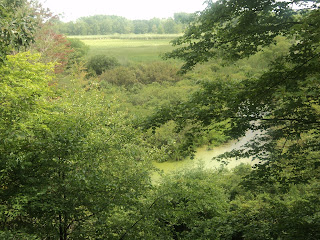Trails: Trapper’s Run and Cherry Island Trails
Hike Location: Lake Erie Metropark
Geographic Location: east of Rockwood ,
MI (42.07643, -83.19855)
Length: 2.7 miles
Difficulty: 2/10 (Easy)
Date Hiked: August 2017
Overview: A pair of flat loops through the marshes along the
Detroit River
Park Information: http://www.metroparks.com/parks/lake-erie-metropark/
Directions to the trailhead: South of Detroit, take
I-75 to Huron River Drive
(exit 27). Exit and go east on Huron
River Dr . Take
Huron River Dr. east 2.2 miles to Jefferson
Ave. and turn left on Jefferson
Ave. The
park entrance is 0.2 miles ahead on the right.
Turn right to enter the park, pay the entrance fee (a single daily
entrance fee gets you into every Huron-Clinton Metropark for that day), and
follow signs for the Marshlands Museum Nature Center
The hike: Consisting of 1607 acres, Lake Erie
Metropark sits at the mouths of the Detroit
and Huron Rivers Lake Erie . The amenity-filled park features 5 picnic
shelters, a golf course, a wave pool, and a boat ramp and marina on Lake
Erie . The park also houses
the interesting Marshlands Museum Nature Center Lake
Erie shore. The museum is
only open Wednesday through Sunday, and I enjoyed browsing its exhibits on my
Thursday visit.
Lake Erie
Metropark also features an extensive paved trail system open to both hikers and
bikers. In terms of hiker-only trails,
the park offers two short unpaved nature trails: the Trapper’s Run and Cherry
Island Trails. Both of these trails give
a fantastic tour of the wetlands bordering Lake Erie . While you could hike the two trails
separately, their trailheads are close enough to merit combining them into a
single hike, which is the route described here.
While I have not visited all 13 of the Huron-Clinton Metroparks, my
experience here leads me to believe that Lake Erie Metropark is the best
metropark in suburban Detroit .
 |
| Start of Trapper's Run Trail |
To “save
the best for last,” I chose to hike the Trapper’s Run Trail first. A counterclockwise journey around the
Trapper’s Run Trail starts by walking across the grassy area to the left
(north) of the Marshlands Museum
At 0.1
miles, where the Big Turtle Shortcut exits left, you reach the first of three Detroit
River Detroit
River
 |
| Detroit River overlook |
Just past
0.4 miles, you reach the hike’s northernmost point where a short boardwalk
takes you through some tall sedges. This
boardwalk also provides the Trapper’s Run Trail’s last Detroit
River
 |
| Riley Creek Overlook |
At 0.7 miles,
the other end of the Big Turtle Shortcut enters from the left just before a
boardwalk exits right. A short detour
down the boardwalk brings you to Riley Creek Overlook, which overlooks its
stagnant and shallow namesake creek.
Back on the main trail, two more left curves, a right curve, and a final
boardwalk bring you out at the Marshlands
Museum
To get to
the Cherry Island Trail and our second loop, walk across the parking lot toward
the Marshlands Museum
 |
| Start of Cherry Island Trail |
The Cherry
Island Trail parallels the boat launch access road as it crosses the first of
several long boardwalks. This boardwalk
takes you over a nice wetland, but dense cattail growth ensures that better
wildlife viewing opportunities will come later.
1.6 miles into the hike, you arrive at the boat launch parking lot. Turn right and look for the dirt/gravel trail
reentering the forest at another “Nature Study Area” sign.
 |
| Cherry Island Trail boardwalk |
For the
next 0.6 miles the Detroit River North America .
Just past 2 miles into the hike,
you reach another boardwalk that crosses open water and (finally!) gives a
clear Detroit River
 |
| Wide Detroit River view |
On the south side of the bridge,
the trail curves left to pass in between a couple of lagoons that support lotus
colonies. The flowers were in full bloom
on my early August visit, but these colonies are not as large as the ones at
nearby William C.
Sterling State Park
 |
| Lotus colony |
At 2.3 miles, you reach the end of
the Cherry Island Trail at its south intersection with the paved bike
path. Turn right on the paved bike path,
which at first follows the boundary between meadow on the left and forest on
the right and thus offers more good wildlife viewing. The meadow flowers were also in full bloom on
my late summer visit. Follow the paved
bike path back to the Marshlands Museum



































